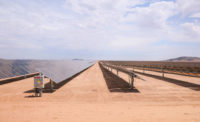ENR Mountain States 2023 Best Projects
Best Project, Energy/Industrial: Sun Mountain Solar

Photo by Tim O'Hara Photography
Sun Mountain Solar
Pueblo, Colo.
Best Project
Submitted by: McCarthy Building Cos.
Owner: Lightsource bp
General Contractor: McCarthy Building Cos.
Civil Engineer: Lamp Rynearson Inc.
Electrical Engineering: McCalmont Engineering
Tracker System: Array Tech Inc.
Modules: First Solar
Civil Subcontractor: H2 Enterprises LLC
One of the largest solar projects ever completed in Colorado, Sun Mountain spans more than 1,700 acres and delivers more than 300 MW of energy.
The project team focused on delivering an efficient plant that would maximize its energy production capabilities for the surrounding community and end users. Sun Mountain achieved 99% of the targeted capacity of 152,057 kW— exceeding the guaranteed capacity by 2%—upon its on-time completion in November 2022.
Crews installed a total of 636,990 ultra-low carbon solar panels with the EPEAT ecolabel, manufactured by Arizona-based First Solar, along with smart solar trackers manufactured by New Mexico-based Array Technologies.
McCarthy incorporated principles of soil science, ecology and practical field experience to create a wide-ranging revegetation plan that involved weed management, conserving preconstruction vegetation and an over-seeding program featuring native grasses to enhance the long-term sustainability of the site.
During civil design, the contractor’s stormwater management experts eliminated sediment basins and instead managed water on the site. Surrounding landowners also identified areas that were prone to erosion, held water or saw water flows during storm events, which helped with the creation of an engineered stormwater plan.

Photo by Tim O'Hara Photography
McCarthy also produced a topsoil map for the property and quantified topsoil depths via a survey prior to earthwork, which led to optimized grading and pile designs to mitigate topsoil impacts. However, the types of soils, their mix and the naturally compacted conditions in the area created some difficulties in driving piles to the designed depth, taking longer than planned. Crews installed piles to the minimum depth, then cut them to the proper reveal height from the ground. This ensured the piles would structurally support the trackers, while pull-testing verified the piles would perform as the original design dictated.
More than 400 people built Sun Mountain, 250 of whom were hired locally. McCarthy’s training program gave individuals of all levels the opportunity to learn necessary skills for long-term careers in the solar industry.



